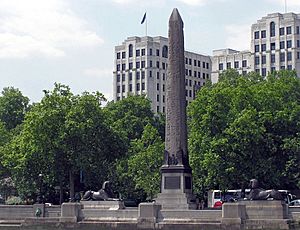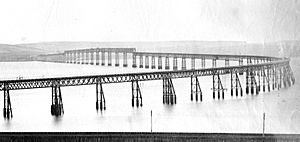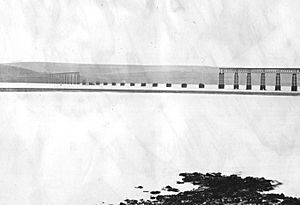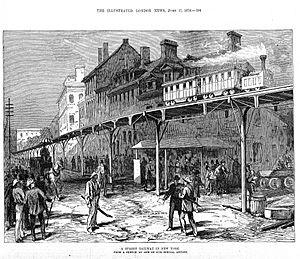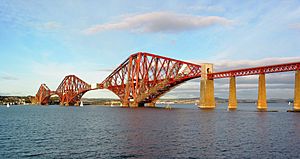Benjamin Baker (engineer) facts for kids
Quick facts for kids
Benjamin Baker
|
|
|---|---|
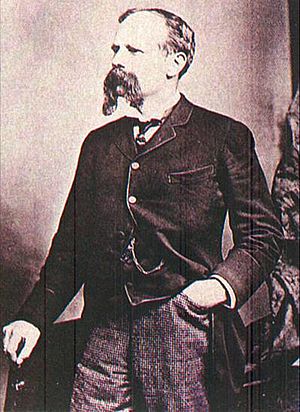
Benjamin Baker as a young engineer
|
|
| Born | 31 March 1840 Frome, Somerset, England
|
| Died | 19 May 1907 (aged 67) Pangbourne, Berkshire, England
|
| Nationality | English |
| Citizenship | United Kingdom |
| Education | Apprenticed to Messrs Price and Fox at the Neath Abbey Iron Works |
| Occupation | Engineer |
| Engineering career | |
| Discipline | Civil engineer Structural engineer |
| Projects | Forth Bridge, First Aswan dam |
Sir Benjamin Baker (born March 31, 1840 – died May 19, 1907) was a brilliant English civil engineer. He lived and worked during the Victorian era. He helped build some of London's first underground railways. He worked alongside Sir John Fowler on these projects. Sir Benjamin Baker is most famous for his amazing work on the Forth Bridge. He also made many other important contributions to engineering. For example, he was an expert witness after the Tay Rail Bridge disaster. Later, he helped design and build the first Aswan Dam in Egypt.
Contents
Early Life and Engineering Start
Benjamin Baker was born in 1840 in Keyford, England. This area is now part of Frome, Somerset. His father, Benjamin Baker, was an assistant at an ironworks. At 16, Benjamin became an apprentice at Neath Abbey Iron Works. This means he learned engineering skills on the job.
After his apprenticeship, he worked as an assistant for two years. Later, he joined Sir John Fowler in London. He helped build the Metropolitan Railway, which was London's first underground train system. He also played a key role as an expert during the investigation into the Tay rail bridge disaster in 1879.
He designed a special cylindrical ship. This ship was used to bring Cleopatra's Needle from Egypt to England. This happened between 1877 and 1878. Today, the Needle stands proudly on the Thames Embankment in London. Benjamin Baker worked on many big engineering projects of his time.
Building Amazing Bridges
In the 1870s, Benjamin Baker wrote an important book. It was about building long railway bridges. He suggested using steel, which was a new idea then. Steel is much stronger than other materials like cast iron. His book showed that steel could allow for much longer bridge spans. This was a very forward-thinking idea for its time.
Tay Bridge Disaster Inquiry
In 1880, Benjamin Baker was asked to be an expert witness. This was for the inquiry into the Tay Rail Bridge disaster. Part of this bridge had collapsed into the water. Baker was representing the builder, Thomas Bouch. However, he did his job very fairly and carefully.
He disagreed with the idea that strong winds blew the bridge down. He carefully checked other structures near the bridge. He found that the wind speeds could not have been that high. The official report said a strong wind pressure was needed to make the bridge fall. But Baker showed that the pressure was much lower. He looked at small walls, ballast on the track, and signal boxes. These would have been damaged if the wind was as strong as suggested.
Baker told the court that he had built many miles of railway viaducts. He was referring to his design of the elevated railroad in New York City in 1868. Parts of this elevated railway still exist in Manhattan today.
By this time, he was known as an expert in bridge building. Soon after, he started working on the project that made him famous. This was the design and construction of the Forth Bridge in 1890. He worked with Sir John Fowler and William Arrol. The Forth Bridge was a unique design. It was a huge cantilever bridge. It was also built completely out of steel, which was new for such a large bridge. Baker used hollow steel tubes to make the bridge very strong. He gave many public talks about his design. He even used his assistants to show how a cantilever bridge works.
The Amazing Forth Bridge
Sir Benjamin Baker and Sir John Fowler designed the Forth Bridge. They did this after the Tay Bridge collapsed. The Forth Bridge is a cantilever bridge. Baker gave many talks explaining how his design worked. The original builder for the Forth Bridge was Thomas Bouch. But he lost the contract after the Tay Bridge inquiry.
The Forth Bridge was built entirely from steel. Steel is much stronger than cast iron. Baker used hollow steel tubes to create the cantilever design. At the time, it was the biggest bridge of its kind in the world. Many people still see the bridge as an engineering wonder.
The bridge is about 8,296 feet (2.5 kilometers) long. The railway tracks are 151 feet (46 meters) above high tide. It has two main sections, each 1,710 feet (521 meters) long. It also has smaller side and approach sections. The three large cantilever towers are 340 feet (104 meters) tall. Each tower's base is 70 feet (21 meters) wide.
Building the bridge was a huge task. At its busiest, about 4,600 workers were involved. Sadly, 98 lives were lost during construction. However, eight men who fell were saved by boats below. More than 55,000 tons of steel were used. Also, 18,122 cubic meters of granite and over eight million rivets were needed.
The Prince of Wales opened the bridge on March 4, 1890. He later became King Edward VII. He drove in the very last rivet, which was made of gold.
Using a cantilever design for a bridge was not new. But Baker's bridge was huge and groundbreaking. Many things done during its construction were new. This included calculating stresses and planning for future maintenance. They also had to consider wind pressure, especially after the Tay Bridge disaster.
The bridge used natural features to its advantage. It used Inchgarvie, an island, and the high banks on both sides of the firth. You can still see parts of Thomas Bouch's earlier bridge attempts on the island.
Trains on the bridge have speed limits. Passenger trains can go up to 50 mph (80 km/h). Freight trains are limited to 20 mph (32 km/h). The bridge was built to handle even heavier steam locomotives. In 2006, about 190-200 trains crossed the bridge each day.
The phrase "Painting the Forth Bridge" means a never-ending task. This comes from a mistaken belief that the bridge was always being repainted. As soon as one repaint finished, another would start. But this was not true. The bridge did have a permanent maintenance crew for a long time.
A new painting project started in 2002. It was expected to finish in 2009. This project involved painting a huge area and cost a lot of money. This new paint is expected to last at least 25 years. In 2007, a report said the Forth Bridge could last for over 100 more years.
Awards and the Aswan Dam
After the Forth Bridge was finished in 1890, Benjamin Baker received an honor. He was made a Knight Commander of the Order of St Michael and St George (KCMG). In the same year, the Royal Society made him a fellow. This recognized his scientific achievements. In 1892, he and Fowler won the Poncelet Prize from the French Academy of Sciences.
Ten years later, the first Aswan Dam was officially opened. Benjamin Baker was the main consulting engineer for this project. For his work, he was made a Knight Commander of the Order of the Bath (KCB). He also served as the president of the Institution of Civil Engineers from 1895 to 1896. He became an honorary member of the American Academy of Arts and Sciences in 1899. In 1902, he was made an Honorary Fellow of the Royal Society of Edinburgh.
London's Underground Railways
Benjamin Baker was also very important in developing London's underground railways. He helped introduce the system of building deep, round tunnels. These tunnels were made from cast iron segments. This method became widely used in London. He was also involved in a plan in 1899 for a new tube line. This plan for north-west London did not go ahead.
His Writings
Baker wrote many articles about engineering. In 1872, he wrote a series called "The Strength of Brickwork." In these articles, he argued that the strength of cement should not be ignored. He said that if it were ignored, many structures of his time should have fallen down.
Later Life and Legacy
Sir Benjamin Baker passed away in Pangbourne, Berkshire. He lived there in his later years. He was buried in the village of Idbury in Oxfordshire. A beautiful stained glass window in Westminster Abbey honors his memory.


